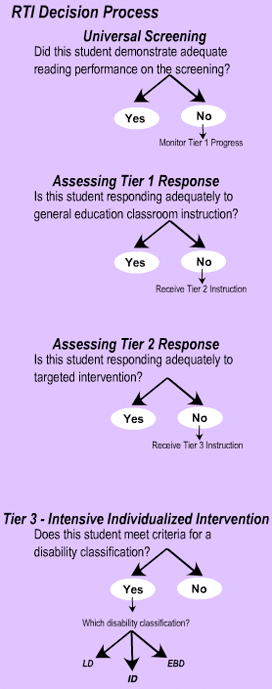RTI (Part 2): Assessment
Wrap Up
In general, RTI serves two primary purposes:

- It allows for early intervening—the identification of struggling students before they fall too far behind their peers—as well as the provision of several levels of instruction to meet their needs.
- It facilitates the identification of students who may have learning disabilities.
More specifically, RTI assessment procedures:
- Identify students who may struggle academically by administering the universal screening
- Document students’ progress by collecting progress monitoring data
- Determine the adequacy of each student’s response to instruction in order to decide on the appropriate level of instructional intensity (i.e., tier decision) by evaluating the progress monitoring data
- Guide instruction by utilizing the progress monitoring data
The figure below outlines the RTI assessment procedures for each tier and provides a review of the RTI decision process.
 Universal Screening:
Universal Screening:
- ALL students are assessed.
- Struggling students are identified.
Tier 1:
- All students receive high-quality instruction.
- The progress of struggling students’ is monitored for 5–10 weeks.
- Students who do not respond adequately to Tier 1 instruction are identified.
Tier 2:
- Students receive targeted intervention for a minimum of 10 weeks.
- The progress of these students’ is monitored during this intervention.
- Students who do not respond adequately to Tier 2 intervention are identified.
Tier 3:
Students receive more intensive intervention through either:
- General education
- Special education
Universal Screening: Did this student demonstrate adequate reading performance on the screening? If not, monitor Tier 1 progress.
Assessing Tier 1 Response: Is this student responding adequately to general education classroom instruction? If not, receive Tier 2 intervention.
Assessing Tier 2 Response: Is this student responding adequately to targeted intervention? If not, receive Tier 3 intervention.
Although the assessment procedures for RTI may seem overwhelming, listen as Candy Justa, a kindergarten teacher, describes how easy it is to implement progress monitoring in the classroom (time: 0:24).
Candy Justa
Kindergarten teacher, Popham Elementary School
Del Valle, Texas

Transcript: Candy Justa
For both the student and the teacher, it is simple. It is a simple assessment. It takes one minute. It doesn’t take very much time. I just think it’s just so simple and quick. You just have to have that mindset: I am going to make time for this. This is what’s most important. It’s important for the child and their parent. This is something I could just whip out no matter what time, what day of the week the parent comes in.
Revisiting Initial Thoughts
Think back to your initial responses to the following questions. After working through the resources in this Module, do you agree with your Initial Thoughts? If not, what aspects of your answers would you change?
What is RTI?
How will teachers initially identify struggling readers?
How will teachers determine which students need more intensive instruction?
When you are ready, proceed to the Assessment section.